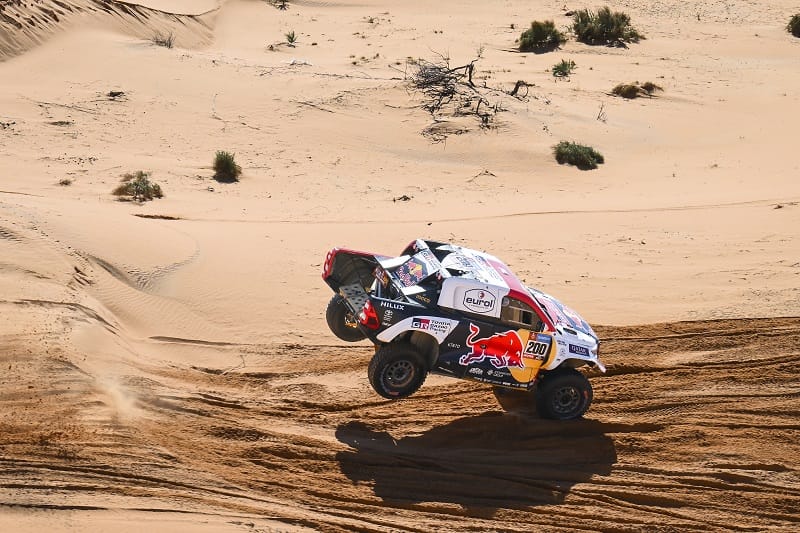Nasser Al-Attiyah was not a happy man ahead of the Dakar Rally‘s fifth stage as his T1 rivals at Team Audi Sport were permitted by the FIA and ASO to boost their cars under the Equivalence of Technology policy. After voicing his frustration online, he unleashed his anger on the track as he held off Audi’s Carlos Sainz and Stéphane Peterhansel for the stage victory.
Outlined in Article 13.3 of the World Rally-Raid Championship regulations, Equivalence of Technology, also known as Balance of Power, is a concept derived from the FIA World Endurance Championship that allows the W2RC Committee to modify the acceleration of cars in the T1.U and T1+ subcategories. During marathon rallies like Dakar, the data is accumulated during a three-stage stretch with a one-day break; this means Stages #1 through #3 were used to collect information before a final output was given during the fourth leg and implemented for the fifth. Ahead of Stage #5, the Committee ruled to increase the power of T1.U cars, like Audi’s RS Q e-tron E2, by eight kilowatts to 271 kW. The rule is intended to provide a level playing field between different fuel sources as the T1.U class is for electric vehicles.
Al-Attiyah, who races a Toyota Hilux in the petrol-based T1+, sarcastically called it “a surprise to give our main rival 11 hp more!! Thank you for killing the race early.” X-raid Team president Sven Quandt criticised Al-Attiyah for his unprofessionalism, commenting that “it was agreed by all top teams including Toyota to accept whatever the FIA decide. If it would have been in favour of anybody else, Audi would have accepted this as well. Before one writes a comment like this Nasser, talk to your team principals at Toyota as we all agreed to accept it without getting polemic.”
“The Equivalence of Technology adjustment is part of the Cross-Country Rally Sporting Regulations,” reads a post-stage statement from the W2RC Committee. “It was introduced at the request of the manufacturers and teams, who wanted a correction mechanism during the Dakar Rally given the unusually long nature of the event. The FIA agreed to implement the Equivalence of Technology mechanism in a process which lasted several months and involved all T1 .0 and T1 + competitors. Teams provided simulation or test data to allow the FIA to calibrate its calculation tools. The final Equivalence of Technology process was agreed by all manufacturers.
“In relation to yesterday’s decision by the W2RC Committee to adjust the Equivalence of Technology for T1+ and T1.U, the data from Stages 1, 2 and 3 showed a gap in favour of T1+ in the region of 9.3kW. In accordance with the Regulations, it was therefore decided by the W2RC Committee to grant a power increase of 8kW for T1.U from Stage 5 onwards.”
Quandt concluded, “By the way you are leading by 18 Minutes and told everybody at the press conference you know the empty quarter like your home.” Seemingly taking that as a challenge, Al-Attiyah proceeded to increase his overall lead by four minutes as he won the 645-km loop around Ḥa’il with a time of 4:13:23, nearly two minutes ahead of Sainz and 3:44 on Peterhansel.
The win, his second of 2023, was no walk in the park. Due to the circumstances and an especially difficult sand layout, Al-Attiyah and multiple racers found themselves exhausted by the end.
“It was a very tough stage,” said Al-Attiyah. “We tried to push like crazy and took a lot of risk. Now we’re tired after pushing so much.”
Stage #4 winner Sébastien Loeb and Laia Sanz were not as lucky as both flipped their cars. Although Loeb was able to right his Prodrive Hunter and finish ninth, it was only another chapter in a frustrating 2023 Rally for the Hunters.
“We had great speed today, genuine speed. In fact, we were up on time after such a good run with the car,” said Loeb. “We started first and no one overtook us but that stage was really rough with a lot of camel grass meaning we took some big hits. If you are the first car opening the stage, you still have to find the line. It’s very different to follow bike tracks rather than car tracks. Indeed, towards the end of the stage I reckoned there were only thirty bikes left in front of me.
“Then, after a crest on a broken dune we had our moment as on the way down it going up again on the left so it was a strange hole but we hit that up and then it tipped us on to the side. It was only 20 kms from the end so it would’ve been good to have got a hat trick of wins for the Prodrive Hunter.”
The Bikes were not exempt from the drama either, most notably when the previous stage victor Joan Barreda and his fellow leaders Skyler Howes, Pablo Quintanilla, and Toby Price all got lost while finding a checkpoint. The group linked up with Adrien van Beveren and tailed him onto the right path, but Barreda fell and his bike was clipped by Price, knocking Barreda unconscious. Price and the others elected to wait until Barreda recovered before continuing their race, which earned them minutes removed from their final times. Barreda would place fourteenth.
Van Beveren, a day after turning 32, claimed the stage win ahead of Honda team-mate José Ignacio Cornejo.
“This stage win was a late anniversary present. It feels great to reach this performance, I am really happy,” said van Beveren. “I did a good navigation at the beginning, then I opened around 200 kilometers. The terrain was really difficult but I could reach my goal.”
Howes finished fifth to assume the RallyGP overall lead. Previous leader Daniel Sanders suffered a severe case of food poisoning the previouis night that greatly impacted his performance and limited him to a twenty-first-place run that dropped him to eighth.
Medical problems also befell Rally2 rider Camille Chapelière, who withdrew before the stage after a crash in Stage #4 caused a swollen bicep. Fellow class rider Ace Nilson, a friend of The Checkered Flag, crashed upon hitting a rut 172 kilometres into the leg; despite being able to finish the stage, he withdrew from Dakar as he suffered non-displaced fractures of his T-4, T-5, and T-6 vertebrae plus bilateral fractures of his sternum/rib junction. His team-mate Jacob Argubright, a fellow American and Dakar newcomer, was more fortunate as he notched his maiden Rally2 podium in third behind new class leader Romain Dumontier and Mathieu Doveze.
In the Quad category, Alexandre Giroud‘s streak of winning every stage was snapped as he finished fifth, but the four consecutive victories (fifth including the Prologue) means his 47-minute advantage over Stage #5 winer Francisco Moreno Flores only drops by eight minutes.
Stage #5 winners
| Class | Number | Competitor | Team | Time |
| T1 | 200 | Nasser Al-Attiyah | Toyota Gazoo Racing | 4:13:23 |
| T2 | 250 | Ronald Basso* | Team Land Cruiser Toyota Auto Body | 7:08:39 |
| T3 | 301 | Seth Quintero | Red Bull Off-Road Junior Team | 4:59:55 |
| T4 | 400 | Rokas Baciuška | Red Bull Can-Am Factory Team | 5:02:52 |
| T5 | 508 | Aleš Loprais* | InstaForex Loprais Praga | 5:06:57 |
| RallyGP | 42 | Adrien van Beveren | Monster Energy Honda Rally Team | 4:27:28 |
| Rally2 | 17 | Romain Dumontier | Team Dumontier Racing | 4:42:22 |
| Malle Moto | 99 | Javi Vega* | Pont Grup Yamaha | 5:23:06 |
| Quad | 154 | Francisco Moreno Flores* | Drag’on Rally Team | 5:49:21 |
| Classic | 709 | Ondrej Klymciw* | Klymciw Racing | 12 points |
Leaders after #5
| Class | Number | Competitor | Team | Time |
| T1 | 200 | Nasser Al-Attiyah | Toyota Gazoo Racing | 20:47:36 |
| T2 | 250 | Ronald Basso* | Team Land Cruiser Toyota Auto Body | 40:53:58 |
| T3 | 304 | Guillaume de Mevius | GRallyTeam | 24:15:39 |
| T4 | 406 | Rodrigo Luppi de Oliveira | South Racing Can-Am | 25:13:20 |
| T5 | 508 | Aleš Loprais* | InstaForex Loprais Praga | 24:30:26 |
| RallyGP | 10 | Skyler Howes | Husqvarna Factory Racing | 23:16:37 |
| Rally2 | 17 | Romain Dumontier | Team Dumontier Racing | 24:43:59 |
| Malle Moto | 99 | Javi Vega* | Pont Grup Yamaha | 27:36:26 |
| Quad | 151 | Alexandre Giroud* | Drag’on Rally Team | 28:46:12 |
| Classic | 778 | Juan Morera* | Toyota Classic | 174 points |




